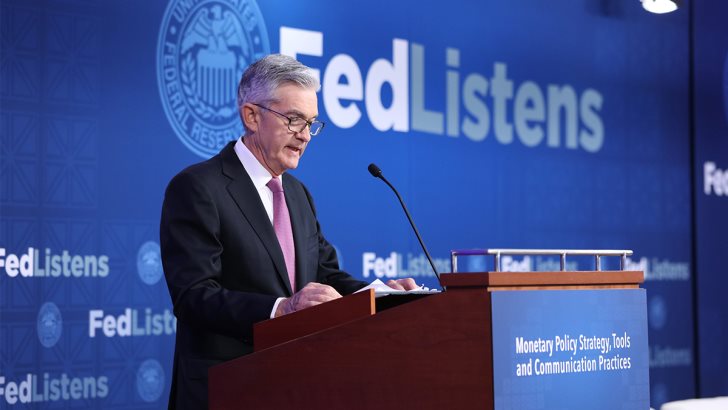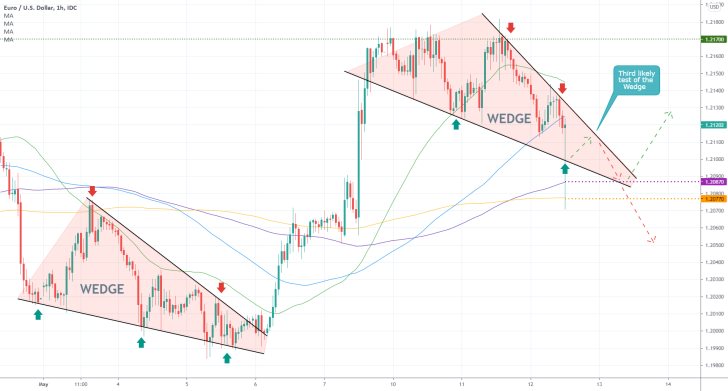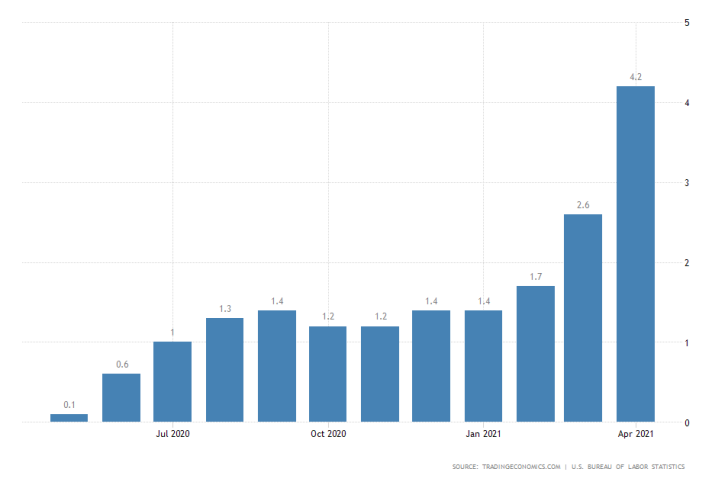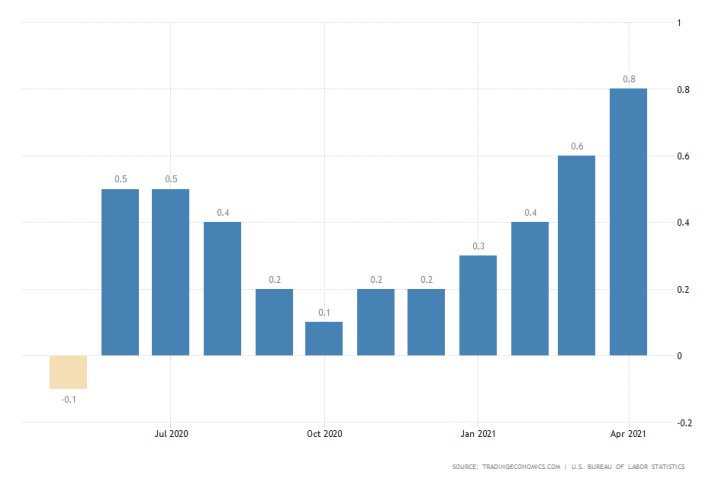
The EURUSD dropped more than 40 pips following the release of the highly anticipated CPI data in the U.S. for April, but then the pair was able to recuperate from the initial shock by the end of the hour.
The dollar's initial reaction was to blast off after it was revealed that the annual inflation rate reached 4.2 per cent last month, way above the initial expectations. This performance manifests the rising fears of consumer prices getting out of hand.

The EURUSD developed another descending Wedge pattern, this time from the major resistance level at 1.21700. While this type of pattern typically entails the likely continuation of an existing uptrend, the battle between bears and bulls may yet throw the pair in either direction.
The 50-day MA (in green) and the 100-day MA (in blue) serve as floating resistances. Meanwhile, the 150-day MA (in orange) and the 200-day MA (in purple) take the roles of floating supports.
The price action is likely to test the two boundaries of the Wedge at least one more time each before a decisive breakout/breakdown occurs.
The bullish rebound from 1.20770 immediately after the release of the report signifies the strong buying pressure there. Hence, bears should look for a decisive breakdown below said level to confirm their hopes for a deeper correction.
In contrast, market bulls would likely be eyeing a potential continuation of the rebound towards the major resistance level at 1.21700.
Rising demand, soaring prices
Headline inflation nearly doubled in just a single month, which is owing mainly to the robust demand for energy. This trend follows the underlying rally on the price of crude oil.

The consumer price index surged by 0.8 per cent, which marks the fourth consecutive monthly gain. The recorded performance surpassed the 0.6 per cent growth that was posted in March. It also outstripped completely the preliminary forecasts, which were projecting a much more moderate uptick of only 0.2 per cent.

The sharp jump in consumer prices in April may compel Jerome Powell and his colleagues at the Federal Reserve to recalibrate their policy stance much sooner than initially projected.
While FED's baseline scenario for recovery anticipated a moderate uptick in inflation past the 2.0 target level in April, the huge upsurge is sufficient enough to compel the FOMC to rethink the scope of its asset-purchasing programmes.
The adoption of a more hawkish policy stance as soon as 2021, with the potential hint of lifting the Federal Funds Rate before the end of the year, is sure to affect the greenback in a transformative way.
Trendsharks Premium
Gold is undergoing a correction, as investors take profits to offset losses from falling stock prices, impacting their margins. However, we anticipate a renewed wave of [...]
The Swiss stock market index is mirroring its global counterparts, such as Germany 40 and US100, experiencing a sharp decline following the announcement of new [...]
We’re analyzing the weekly chart to grasp the broader market trend. Over the past three years, the US30 index has surged by 17,000 points, often resembling a nearly straight [...]
Over the past week, the DAX has experienced a sharp decline, plunging by an astonishing 3,400 points. This downward movement is not isolated, as its international counterparts, such as the UK100 and US100, are also facing significant [...]
EURUSD recently formed a double top at 1.0930, signaling a potential trend reversal, and has since begun a correction. After a 600-pip rally since early March, a pullback at this stage is both expected and healthy. Given these conditions, we are placing a [...]
Since early March, EURJPY has surged nearly 1,000 pips, providing us with several excellent trading opportunities. However, as the rally matures, many early buyers are beginning to take profits, leading to a noticeable slowdown in the uptrend. On Friday, the pair formed a [...]
The AUDJPY currency pair continues to be dominated by bullish momentum, as multiple golden cross patterns reaffirm the strength of the ongoing uptrend. Despite this, we are witnessing a much-needed [...]
The EURAUD currency pair appears to be undergoing a trend reversal, signaling a potential shift in market direction. A notable technical development is the formation of a Death Cross on the chart, a widely recognized bearish indicator that typically suggests a [...]
After securing an impressive 200-pip profit last week, the EURJPY currency pair is now undergoing a southward correction, retracing some of its recent gains. Despite this temporary pullback, the Golden Cross remains intact, reinforcing our view that the overall trend continues to be [...]
The appearance of a Golden Cross in Silver strengthens our analysis that the metal is currently in a strong uptrend, indicating further bullish momentum in the market. This technical pattern, where the short-term moving average crosses above the [...]
This trade presents a considerable level of risk and can be classified as an opportunistic move based on recent price action. The GBPUSD currency pair has experienced a substantial bullish rally, surging by nearly 500 pips in a strong upward movement. However, after this extended period of appreciation, the pair is showing signs of a potential [...]
The anticipated Death Cross on the SMI20 appears to be failing as price finds strong support at the 23% Fibonacci retracement level. After testing this area, the index has shown bullish strength, printing several large green candles, signaling an increase in [...]
A Golden Cross has just appeared on the USDJPY chart, signaling a potential bullish move. This technical pattern occurs when the 20 period moving average crosses above the 60 period moving average, a widely recognized indication of increasing [...]
After 2 months of a down trend, we finally see some indications of price recovery for Oil. The golden cross, a historic buy signal, supports this [...]
For the past month, the German DAX40 has experienced a remarkable 10% surge, reflecting strong bullish momentum. Despite ongoing market volatility and frequent pullbacks, every dip continues to attract fresh buyers, reinforcing the [...]
Oil continues its downward trajectory, despite occasional pullbacks. The overall trend remains bearish, reinforced by multiple Death Cross patterns, a classic sell signal indicating further weakness. Adding to this bearish outlook, the critical [...]
Over the past few days, gold has experienced a sharp decline of more than $100. This downturn can be attributed in part to traders securing profits to manage their margins, which are under strain due to the significant drop in major indices. Currently, gold has fallen below the [...]
The NASDAQ 100 index is showing strong bullish momentum, as evidenced by the formation of a Golden Cross on the chart. This classic buy signal occurs when the short moving average crosses above the long term moving average, suggesting that upward momentum is [...]
The EURAUD currency pair has encountered a significant resistance level, failing to break above the critical 61% Fibonacci retracement level. This suggests that bullish momentum is weakening, reinforcing the case for a potential downward move. Given this technical setup, we favor entering a [...]
The UK100 is experiencing a remarkable rally! Over the past few weeks, the British stock market index has surged nearly 800 points. Each minor dip has attracted more buyers, fueling the bullish momentum. However, since last week, we’ve observed a slight [...]




















